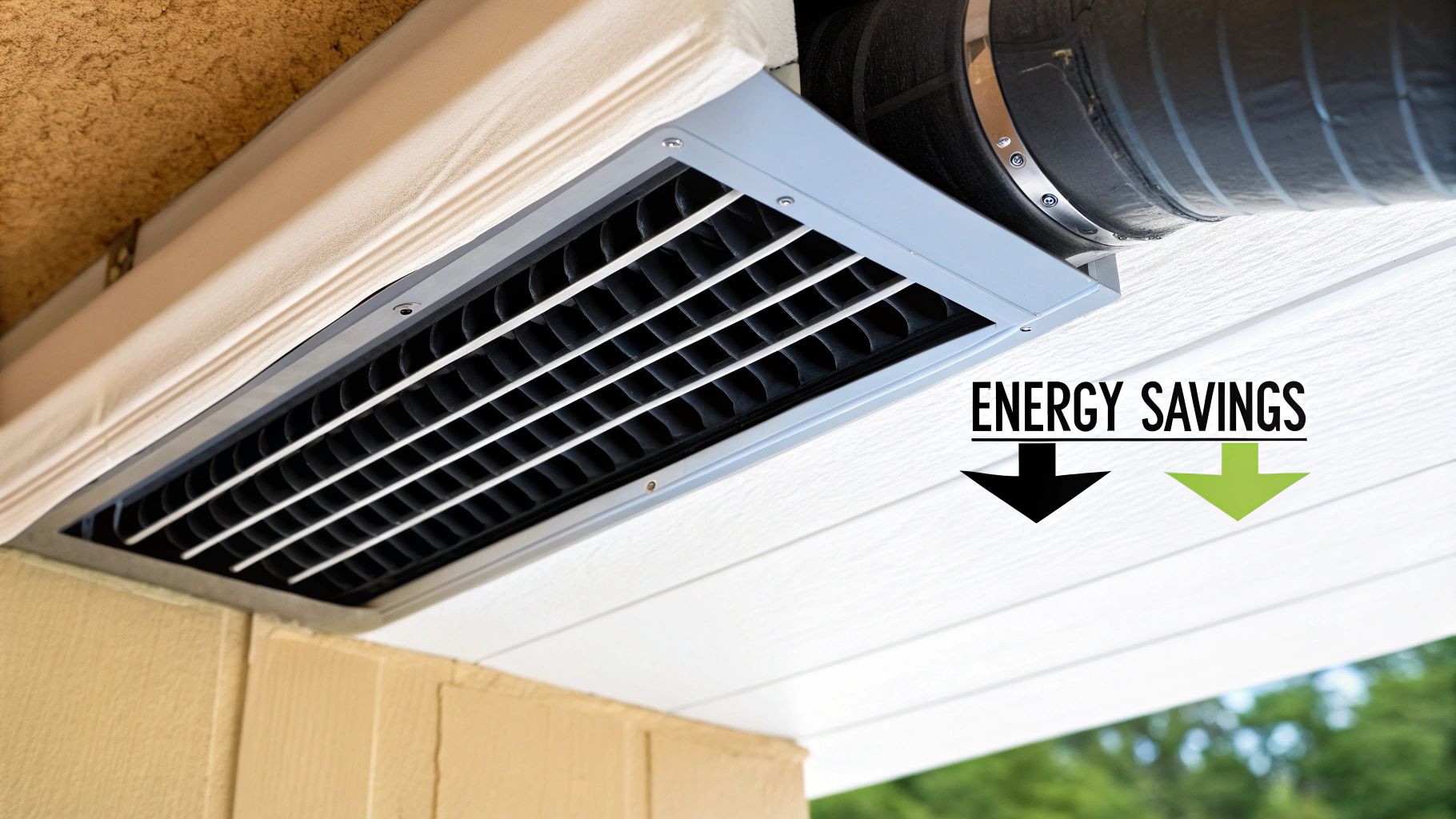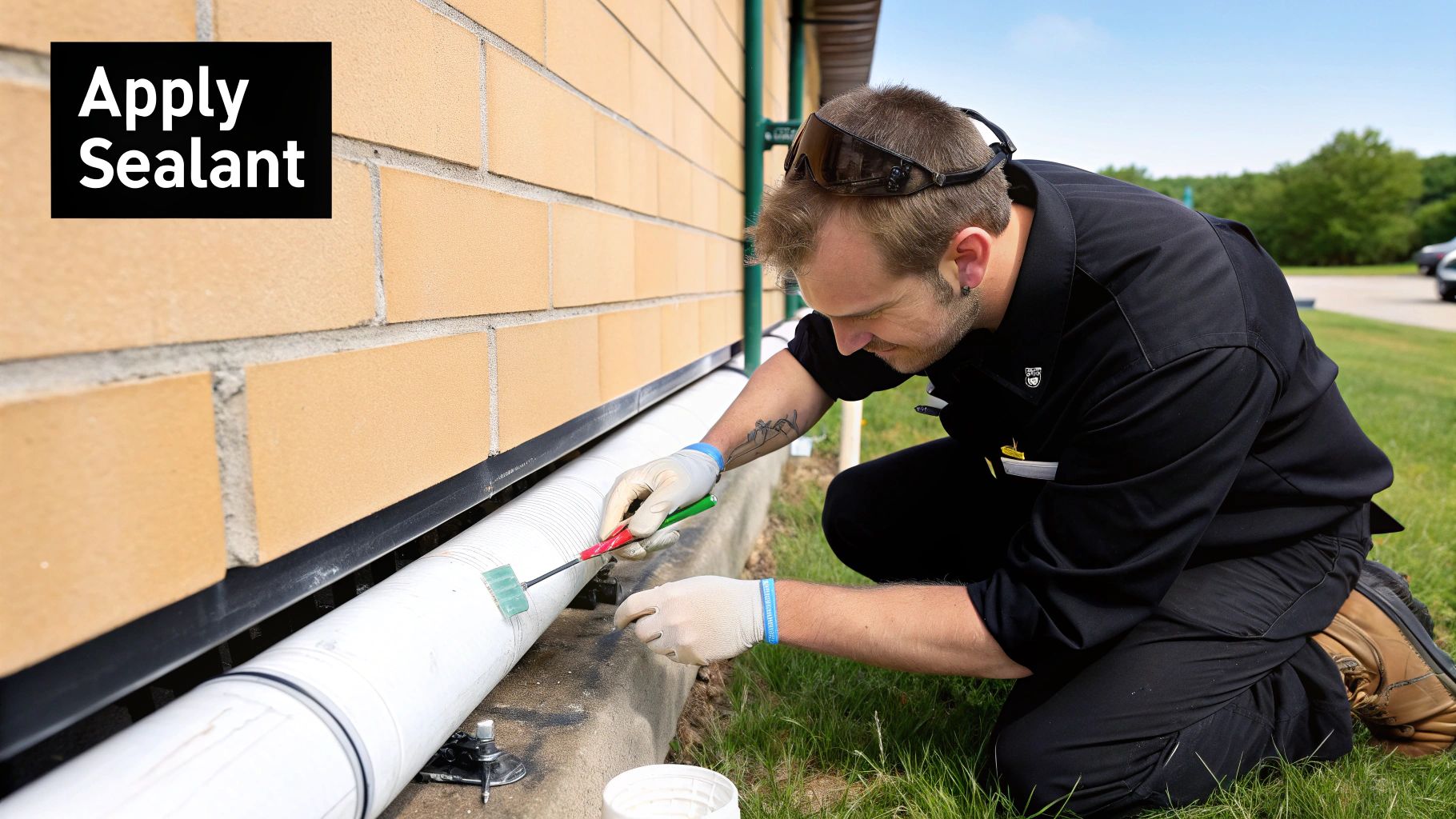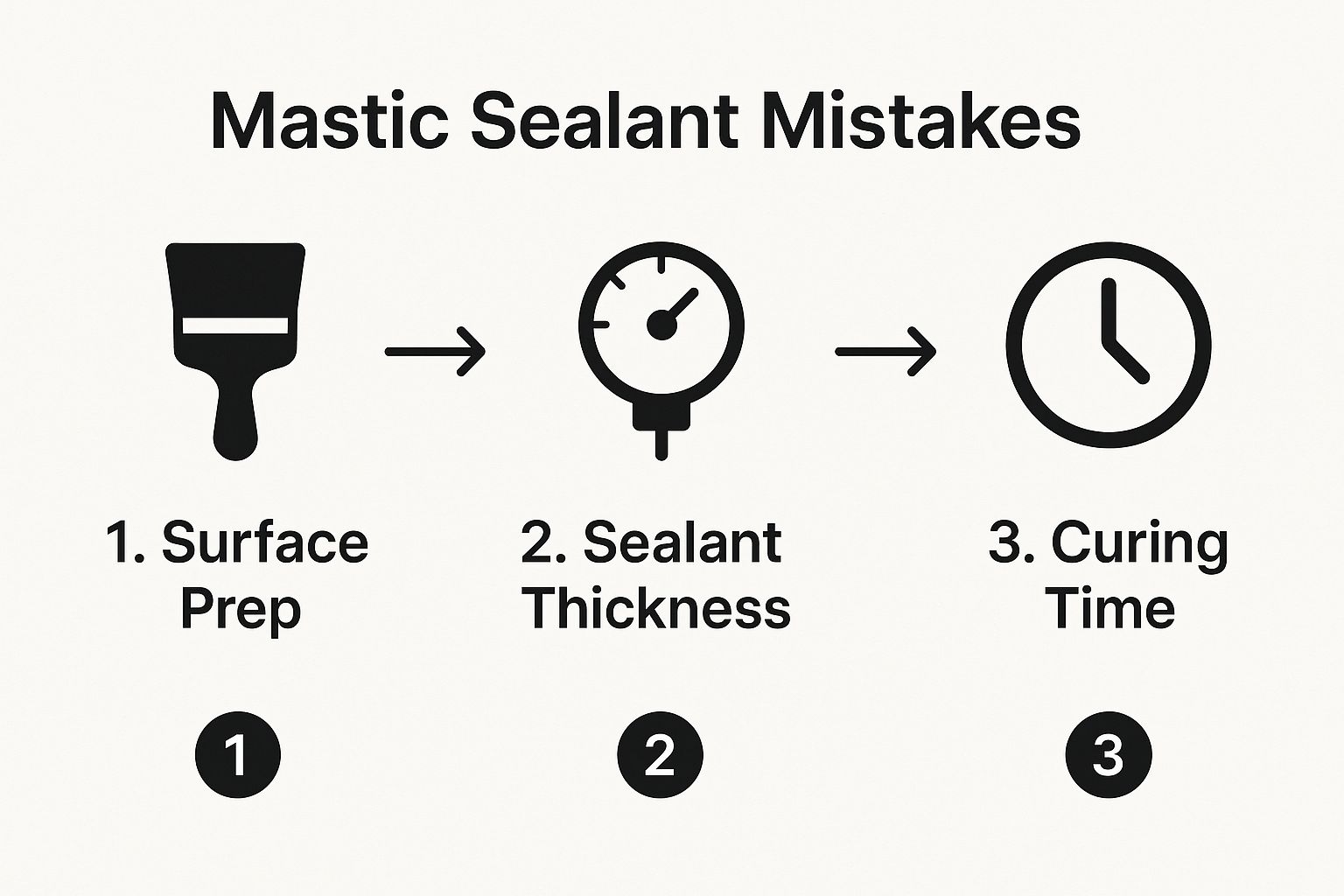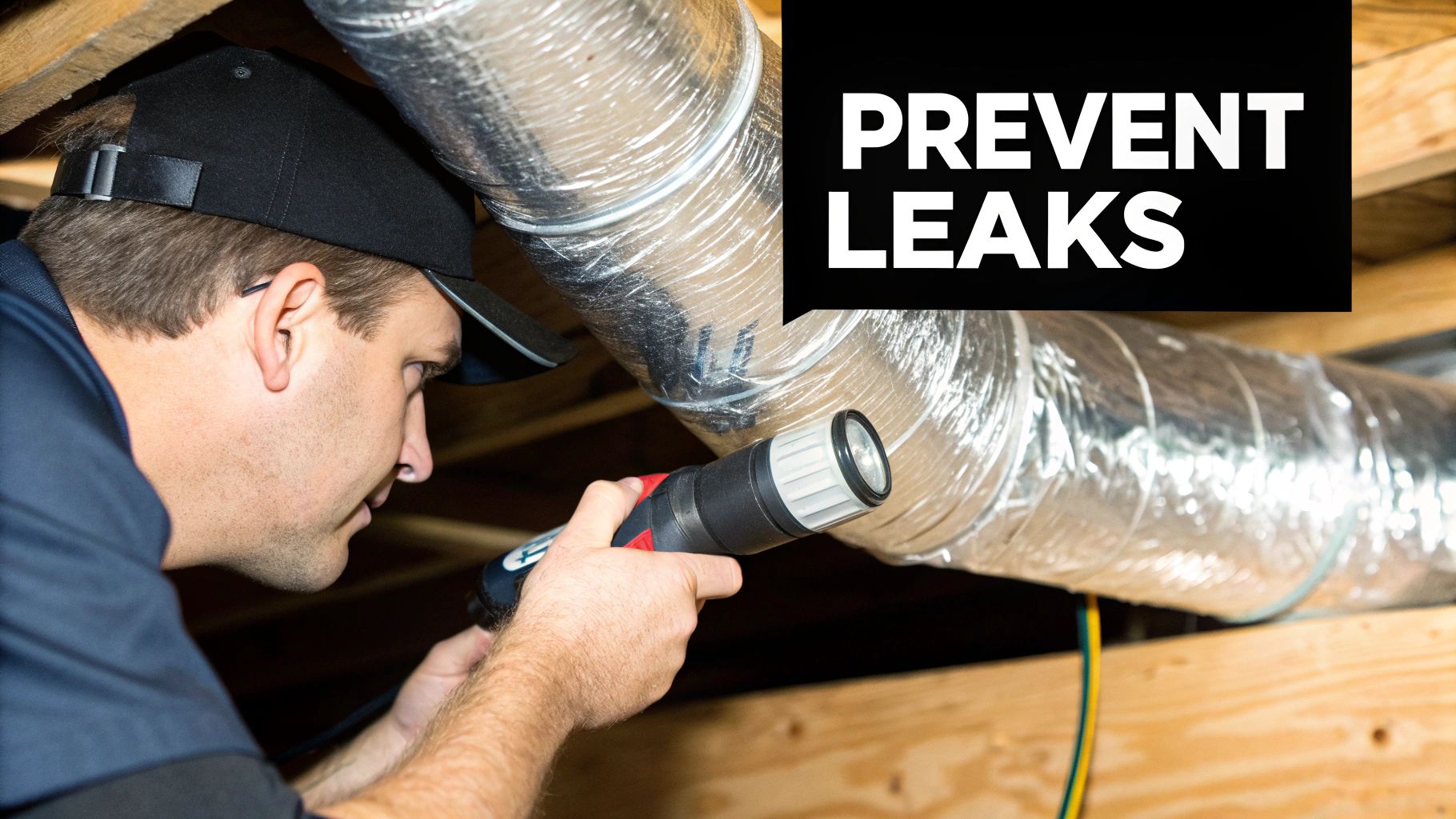If you're tired of seeing your energy bills climb, leaky ducts are a quiet but costly problem. Using mastic sealant on your ductwork is the real deal—a permanent, professional-level fix. Forget temporary patches; this thick, paste-like sealant creates a tough, airtight seal that stops energy waste in its tracks, makes your home more comfortable, and brings down those utility bills.
The Hidden Costs of Leaky Ductwork
Ever notice how one room feels like a tropical jungle while another is an icebox? The reason is probably hidden away in your attic, crawlspace, or basement. Your ductwork is the circulatory system for your home's heating and cooling, but over time, the seams and joints can develop leaks. They might seem small, but their impact is huge.
According to the Department of Energy, a typical home can lose up to 30% of its conditioned air through leaky ducts. That’s the air you've already paid to heat or cool, just escaping into spaces where it does no good. This forces your furnace and air conditioner to work overtime just to keep up, leading to sky-high energy bills and putting extra strain on your expensive HVAC system.
From Wasted Energy to Poor Air Quality
It's not just about the money. Leaky ducts can seriously mess with your home's indoor air quality. When air leaks out of your supply ducts, it creates a pressure imbalance. To make up for the lost air, your system starts pulling in air from wherever it can—dusty attics, musty crawlspaces, or even the garage.
Sealing up those gaps doesn't just boost your energy efficiency. It also stops dust, insulation fibres, and other nasty pollutants from getting into your airstream. The result? The air circulating through your home is cleaner and much healthier for you and your family.
The link between leaky ducts and poor air quality is undeniable. To really understand what might be floating around in your home's air, it’s worth learning about the harmful risks brought by dirty ducts to your health.
Why Mastic Sealant Is the Superior Choice
When it comes to sealing ductwork, not all methods are created equal. Foil tape can work for a quick, minor patch, but it's not a long-term solution. And duct tape? Despite the name, it's the absolute worst choice. The adhesive just can't handle the temperature swings and breaks down fast.
Mastic sealant, on the other hand, was made for this job. It’s a goopy, thick material that you literally paint over all the joints, connections, and seams. Once it cures, it forms a flexible yet rock-solid seal that will last for decades. This is exactly why the pros trust mastic sealant for ductwork on every job.
The difference proper sealing makes is massive. Take commercial buildings in California, for example. A CalNEXT study showed that sealing leaky ducts cut air leakage by an average of 81%. That translated to huge energy savings, including a 64% reduction in heating energy use. While that study focused on commercial spaces, the takeaway for homeowners is clear: sealing your ducts means real savings and a much more comfortable home.
Choosing the Right Mastic and Gathering Your Tools

Before you can even think about sealing up those leaky ducts, you’ve got to get your supplies in order. Picking the right mastic sealant for your ductwork is obviously the most crucial choice, but having the right little tools on hand will make the whole job go a lot smoother.
Selecting Your Mastic Sealant
When you get to the hardware store, you'll likely see a couple of options for mastic. For just about any residential duct sealing job, you're going to want a water-based mastic. It has low VOCs (Volatile Organic Compounds), which means fewer harsh fumes floating around your house. The best part? It cleans up with just a bit of water and a rag. It’s a no-brainer.
The other type, solvent-based mastic, is really more for heavy-duty industrial applications. It’s overkill for a home project and comes with a much stronger odour and more difficult cleanup.
To help you decide, here’s a quick breakdown of the two main types.
Mastic Sealant Selection Guide
| Feature | Water-Based Mastic | Solvent-Based Mastic |
|---|---|---|
| Best For | Residential HVAC ductwork, indoor use | Industrial applications, outdoor use, extreme temperatures |
| Cleanup | Easy; just water and a rag while wet | Requires mineral spirits or other solvents |
| Odour/Fumes | Low; low VOCs, safer for indoor air | Strong; high VOCs, requires significant ventilation |
| Application | Simple, easy to spread, forgiving | Can be stringier and more difficult to manage |
| Drying Time | Slower, typically 24-48 hours to fully cure | Faster, can set up quicker |
| Flexibility | Remains flexible to handle duct expansion/contraction | Tends to dry harder and more rigidly |
For home use, the choice is clear. The ease of use and safety of water-based mastic make it the right tool for the job.
Your Essential Supply List
Let’s talk about what you actually need to grab. The goal here is to be fully prepared so you’re not stuck making a second trip to the store with sticky mastic all over your hands. Trust me, you don't want that.
Here's a practical checklist:
- A Tub of Mastic Sealant: For most homes, a one-gallon tub will give you more than enough to cover all the accessible ducts.
- Disposable Chip Brushes: Don’t waste your money on nice paintbrushes. A couple of cheap, 2-inch chip brushes are perfect for slathering on the thick sealant, and you can just toss them when you're done.
- Gloves: This is a must. Nitrile or latex gloves are your best friends here. Mastic is incredibly sticky and a real pain to get off your skin once it starts setting.
- Rags and a Bucket of Water: Keep a dedicated "mess bucket" handy. A damp rag is invaluable for wiping up drips and cleaning off your putty knife as you go.
- Safety Glasses: It might seem like overkill, but you’ll be glad you have them. Mastic can flick and drip unexpectedly, especially when you're working on ducts over your head.
- Fibreglass Mesh Tape: This is absolutely essential for bridging any gaps wider than an eighth of an inch. It gives the mastic a solid base to grab onto, preventing it from just falling into the gap.
Pro Tip: Don't be cheap with the gloves. Grab a multi-pack. From my experience, you’ll easily go through a few pairs as they get caked in sealant. Having a fresh pair ready to go keeps the job from turning into a sticky disaster.
I'd say a good mastic sealant ductwork job is about 50% preparation. When you gather these specific items beforehand, you're setting yourself up for a clean, efficient process that ends with a professional-quality, airtight seal. This prep work saves a ton of frustration and ensures your effort pays off with a durable, long-lasting fix for your leaky ducts, boosting your home’s energy efficiency for years to come.
How to Prepare Ducts for a Perfect Seal

Any good contractor will tell you that the final result is all in the prep work. This is especially true when it comes to mastic sealant on your ductwork. You aren't just slapping some grey goo on the metal; you're creating the perfect surface for an airtight bond that will last for years. It's the difference between a temporary patch and a professional, long-term solution.
Your first job is to play detective. Grab a flashlight and head down to the basement, up to the attic, or into the crawlspace—wherever your ducts are. Flip your HVAC fan to the "ON" position (no need for heat or AC) to create some airflow.
Run your hand along the seams and joints. You'll often feel tiny drafts where different sections connect, especially at the main trunk line or where the ducts meet the registers. A dead giveaway for a leak is a tell-tale streak of dust fanning out from a seam. That's a sure sign that air has been escaping for a long, long time.
To Clean or Not to Clean
This is a point of debate in the industry: do you really need to clean the duct surface before applying mastic? Technically, some studies have shown that mastic sealant is remarkably forgiving and can stick well even without a deep clean. It's far more durable than traditional tapes, even on surfaces that aren't perfectly pristine.
But from my experience in the field, I always recommend a quick wipe-down. Think about it—if a joint is caked in a thick layer of dust or grime, the mastic is just sticking to that grime, not the duct itself.
Spending just 30 seconds wiping a joint with a dry rag is well worth the effort. It removes the heaviest debris and ensures the sealant gets a solid grip on the metal. It’s a small step that gives you peace of mind and a much better bond.
While you're at it, this is a great time to think about the inside of your ducts, too. Surface prep is one thing, but overall system hygiene is key for air quality. If you want to learn more about keeping the entire system in top shape, check out our guide on how to maintain your air duct systems.
Reinforcing Gaps for a Rock-Solid Seal
Mastic is thick and goopy, but it's not magic. It can’t bridge large gaps all by itself. If you find any connections with a gap wider than about an eighth of an inch (that's about the thickness of two pennies stacked together), you need to give it some backup. This is where fibreglass mesh tape is your best friend.
Here's how to tackle those bigger gaps:
- Cut a piece of fibreglass mesh tape long enough to completely cover the joint.
- The tape is self-adhesive, so press it firmly over the seam, making sure it lies flat.
- Once the tape is secure, apply your mastic sealant right over top of it.
The mesh tape works like rebar inside concrete; it creates a sturdy framework for the mastic to cling to. Without it, the sealant would likely sag into the gap as it dries, leaving you with a weak spot or no seal at all. By using this method, your mastic sealant ductwork repair will be incredibly tough and ready to handle whatever your HVAC system throws at it for years to come.
Applying Mastic Sealant Like an HVAC Pro
Alright, with your ducts cleaned up and your gear all set, it's time for the best part. This is where all that prep work pays off, turning those leaky metal joints into a single, airtight system that saves you money. Don't think of this like reading a technical manual—I'm going to walk you through it just like I would an apprentice on their first job, showing you how to properly apply mastic sealant to your ductwork.
Let’s be clear from the start: the goal isn’t to be neat. It's to be thorough. Applying mastic is a messy job, so just accept that. What you're left with won't be pretty, but it will be incredibly effective at stopping leaks.
Mastering the Application Technique
First off, let's talk about getting the mastic on your brush. Don't be shy here. Grab your cheap chip brush, dip it into the tub, and get a good, generous glob on the end. You're not painting a picture; you’re sealing a fortress. One of the biggest mistakes I see homeowners make is trying to put it on too thin, which just leads to a weak seal that'll crack and fail down the road.
You're aiming for a thickness of about 1.5 to 2 millimetres, or roughly the thickness of a nickel. This gives the sealant enough body to fill every little gap and imperfection, creating a tough, flexible barrier that can handle the expansion and contraction of the ducts as your furnace or AC cycles on and off.
Instead of a smooth, painter-like stroke, use a dabbing or stippling motion. This really pushes the sealant deep into the seam and fills any tiny crevices. You want to completely cover the joint, making sure the mastic extends about one inch onto the metal on both sides of the seam. This gives you maximum surface area for a solid bond.

As you can see, getting that thickness right is a make-or-break step. It has a direct impact on how long your seal will last.
Tackling Different Ductwork Scenarios
Of course, not all duct joints are simple straight lines. You’re going to run into different shapes and connections that need a bit more attention.
Round Duct Joints: For the seams that wrap around round ducts, you'll paint a solid, continuous band of mastic all the way around. Take a second to look for any factory seams running the length of the pipe, too—those need to be sealed just as carefully.
Plenum Connections: The plenum is the big box that connects your main duct lines to the furnace or air handler. These connections are notorious for leaking air. Be extra generous with the mastic here, laying down a thick, heavy seal where the rectangular ducts meet the plenum.
Takeoffs and Boots: You need to be meticulous where smaller branch lines "take off" from the main trunk line, and where the ductwork ends in a register boot in your floor or ceiling. Seal up every single edge and corner where different pieces of metal meet.
Here's a pro tip from years of crawling around tight spaces: when you're stuck in a crawlspace and can't get the right angle with your brush, just use a gloved finger. Honestly, it's often the best tool for the job, letting you push mastic right into an awkward corner of a duct elbow or onto the back of a joint you can barely even see.
Visual Cues of a Job Well Done
So, how do you know you've put enough on? A properly sealed joint won't have any visible metal showing through along the seam. The fibreglass mesh tape you put on earlier should be totally saturated and disappear under a thick, lumpy, grey layer of mastic.
And yes, it should look lumpy and uneven. That's a good sign! It tells you there's enough material to do the job right. A thin, smooth coat might look better, but it won’t give you the durable, permanent seal you need. When it comes to mastic sealant for ductwork, function always wins over form. Once a section is done, step back and look at it from a few different angles to make sure you haven’t missed any spots.
Curing, Inspecting, and Avoiding Common Pitfalls

It’s tempting to call it a day once the lid is back on the mastic tub, but hold on. Getting the mastic sealant onto your ductwork is a huge part of the job, but the final steps—curing and inspecting—are where you lock in those energy savings and comfort gains.
Whatever you do, don't flip your HVAC system back on just yet. That mastic needs to cure properly, which means it has to dry completely and harden into that tough, flexible seal you're after. This usually takes 24 to 48 hours, though a couple of things can speed it up or slow it down.
The two big factors are humidity and temperature. If you're working in a cool, damp basement, expect the cure time to be on the longer side. In a warm, dry attic, it'll set up much faster. Kicking on the furnace or AC too early is a rookie mistake; it forces air through the still-wet sealant, creating little bubbles and weak spots that are guaranteed to leak down the road. It’s worth the wait, trust me.
The Post-Cure Inspection
After giving it at least a full day, it's time to play detective. Grab a good flashlight and go over every single seam and joint you sealed. When it's done right, the mastic will look and feel like a solid piece of rubberized plastic. It should be totally opaque—you shouldn't see any of the joint or mesh tape peeking through.
Give the sealed areas a gentle press. They should feel solid and firm, not gooey or tacky. From my experience, you need to pay extra attention to these tricky spots:
- Thin Spots: Keep an eye out for any areas that look a bit see-through, or where you can almost make out the shine of the metal duct underneath. These are future leaks waiting to happen and will need another coat.
- The Underside of Joints: It’s so easy to do a great job on the top and sides of a duct and completely miss the bottom. You have to get right down there and check the undersides properly.
- Complex Connections: Anywhere ducts come together, especially around the plenum, you'll find all sorts of awkward angles and little gaps. Go over these complex junctions with a fine-tooth comb to make sure every edge is sealed tight.
If you spot a weak point, don't sweat it. The fix is easy. Just goop another layer of mastic right over the area. The new coat will bond perfectly to the first one and make the seal that much stronger.
Avoiding All-Too-Common Mistakes
The amount of energy you can save with properly sealed ducts is massive. And this isn't just a homeowner problem. Leaky ducts are a huge source of waste in commercial buildings, too. Research on light commercial duct systems in California showed that over 85% had major leaks, with an average air loss of a shocking 36% of total fan flow. Sealing them up results in enormous energy savings. You can get more details on these duct sealing findings and their impact on energy use.
The single biggest mistake people make is not appreciating just how much air can sneak through a tiny gap. To get a truly airtight result, nail these three things:
- Apply It Thick: Be generous. A skim coat is a weak coat and will just crack over time.
- Cover Everything: Every single seam, joint, and screw hole needs to be completely covered. No exceptions.
- Respect the Cure Time: Patience is a virtue here. Let that mastic harden all the way.
By taking care of these final details, you'll make sure your mastic sealant ductwork project gives you the professional-quality performance and energy bill relief you were aiming for.
Common Questions About Sealing Ductwork
Even after you've put the tools away, a few questions always seem to surface. When it comes to sealing your home's ductwork with mastic, getting these common queries sorted out gives you the peace of mind that your hard work will actually last.
One of the first things people ask is, "How much of this stuff do I need?" As a good rule of thumb, one one-gallon tub of mastic sealant will cover anywhere from 50 to 75 linear feet of seams. For a typical home around 1,500 to 2,000 square feet, a single gallon should be enough to hit all the accessible joints in your basement or crawlspace. Still, I always recommend buying a little extra. You'll thank yourself later when you need to do a quick touch-up.
Handling Different Duct Types
"What about my flex ducts?" That's another big one. Can you use mastic on them? Absolutely, but only where they connect to something solid. You should never, ever slather mastic all over the flexible, coiled body of the duct itself.
Here’s the right way to do it: First, get the inner liner of that flex duct snug against the metal boot or plenum collar using a heavy-duty zip tie. Then, lay on a generous coat of mastic over the whole connection. Make sure you completely cover the zip tie and the edge of the liner. This creates a permanent, airtight bond where the two different materials meet.
Mastic is incredibly safe for indoor use once it's fully cured. Most water-based mastics are low-VOC, meaning they release very few volatile organic compounds. Just ensure you have good ventilation while working. After the 24-48 hour curing period, the sealant becomes inert and will not off-gas, making it perfectly safe.
Finally, while sealing your ducts boosts efficiency, what about the gunk that's already in there? Sealing stops new dust and debris from getting pulled in, but it does nothing to remove the years of buildup already coating the inside. It's worth looking into the air duct cleaning cost to see if a professional cleaning makes sense for you. Combining a sealed system with a clean one is the ultimate way to boost efficiency and your home's air quality.
For professional duct system inspections and cleaning services in the Greater Toronto Area, trust the experts at Can Do Duct Cleaning. Our experienced technicians ensure your HVAC system runs efficiently and delivers clean air. Visit us online to book your service today!
Article created using Outrank


